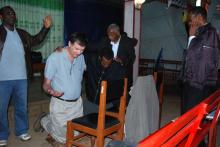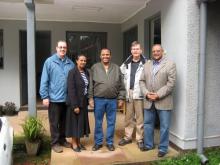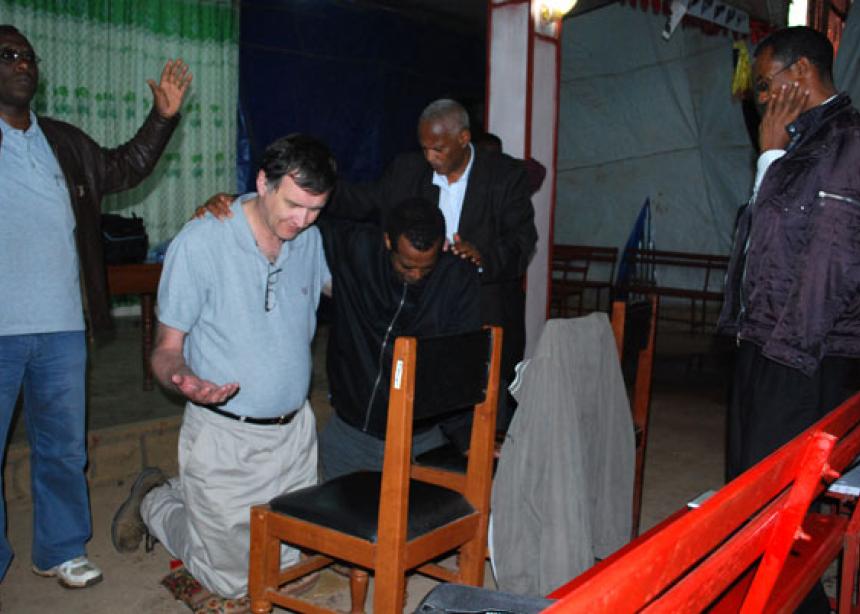As Fanosie Legesse and Steve Brnjas were driving through a small village in rural Ethiopia, their car slowed to pass through a narrow street when suddenly a boy darted into the car’s path, and was hit. His body flew and landed a few feet away. The driver stopped, though hesitantly, sensing there might be trouble. The passengers got out to see how they could help. It didn’t look good.
Legesse of Fergus, Ont., and Brnjas of Waterloo, Ont., were in Ethiopia on a teaching assignment with the Meserete Kristos Church (MKC) in May and June of this year. Meserete Kristos means “Christ the foundation.” Legesse and Brnjas team-taught about leadership with Brnjas giving Biblical examples of leaders while Legesse, an Ethiopian now living in Canada, gave application in the local situation.
Brnjas has pastored in both the Brethren in Christ and in Mennonite churches in Ontario. He most recently worked for Mennonite Central Committee Ontario in their Circles of Support and Accountability. But before all that he was a police officer working for the Waterloo Region. He knelt beside the boy and checked—vital signs absent. Unless there was immediate intervention, the boy was dead.
Legesse responded in an Ethiopian way. Unlike Brnjas he could understand the gathering crowd. “The father is coming. He has a gun.” Vendettas and revenge killings are an unfortunate commonplace in Ethiopia. They were in big trouble. Legesse prayed at the top of his lungs in Amharic, the main Ethiopian language, beseeching God in the name of Jesus to bring this child back. The boy’s eyelids fluttered; he drew a breath. As the father arrived the crowd was in awe—instead of a dead child needing to be revenged, Legesse and Brnjas handed him his very-much-alive son. Alive because of Jesus’ intervention.
Spirit-active church
The MKC has been lumped together with the other Protestant/Evangelical churches in Ethiopia as Pente—charismatic. Some MKC leaders disdain the name, wanting to differentiate themselves from the other churches. But many North American visitors are hard pressed to see the differences, finding the worship and theology in the MKC to be very akin to Pentecostal or charismatic theology.
Founded in 1951 following six years of Mennonite relief work including the development of a hospital, the MKC has always followed its own path. From the beginning covert evangelism was taking place in areas where neither the missionaries nor their converts were to be operating. But it was the Derg socialist period from 1974 to 1991, a period when the church came under increasing pressure, that made MKC what it is today.
Soon foreign missionaries were sent home, property was confiscated, gatherings were banned and religious life frowned upon. But the MKC Christians, believing they needed to follow the higher authority of God in Christ, organized congregations into groups of five people to meet regularly, pray, study scripture and encourage each other. The church, numbering around 5000 in 1982 when it was officially “closed,” resurfaced in 1991 numbering 34,000.
According to Alemu Checole and Samuel Asefa, writers of the Eastern Africa portion of the Global Mennonite History Volume One: Africa, during the years of persecution the church also moved toward a charismatic orientation. While this had begun earlier under indigenous teachers and preachers, the fervour and power found in a Holy Spirit orientation sustained the Christians and churches when they could not openly identify as Christians. But even then questions arose about how charismatic they should be.
Alemu Checole was not healed of his blindness, in spite of fervent prayer. Was he a Christian? Or was healing not always accessible? He writes, “The Lord used the charismatic movement to bring dynamism and vitality into his church” (p. 254). This was exemplified by confession of sins, trust in spiritual work, and the sacrificial giving of time, talents and money.
John Peters, retired professor of anthropology and sociology at Wilfred Laurier University in Waterloo, and a member at Waterloo North Mennonite Church, was amazed on his first trip to teach at the MKC College in Debre Zeit in 2006. Students in his classes spoke naturally of healings, exorcisms and other acts of the Spirit. This was out of his ken in a Mennonite Church environment.
Tim Reimer, pastor at Danforth Mennonite Church in Toronto, noted that speaking in tongues was a normal occurrence during worship when he was teaching Old Testament at MKC College in 2012.
Palmer Becker, a retired teacher and pastor living in Waterloo has also taught at MKC College. He wrote in an email in February 2012, “MEDA was to have the chapel this morning but they cancelled due to illness and at last minute I was asked to speak. President Nagash suggested that I should share my experiences with exorcism! I shared two stories from my ministry. Students said that this was the first time that they had ever heard a North American talk about the Spirit-world. They are asking me to continue tomorrow so I prepared this afternoon by rereading “Even the Demons Submit,” with articles by Paul Hiebert, Willard Swartley and others. This is leading to some very interesting conversations!”
Holistic gospel
Others point to significant differences between the MKC and other groups. Carl Hansen in an article in The Mennonite earlier this year paints a picture of a church which has both strong roots and a hopeful future in Anabaptism.
Doug and Wanda Roth Amstutz, both pastors in Ontario, spent 2007 to 2011 as country representatives for MCC in Ethiopia. They note that the older generation of pastors and leaders, mindful of MKC’s roots in Mennonite mission work, self identify as Anabaptist. Younger generations, especially as they are educated at MKC College are rediscovering those roots, and applying Anabaptist thinking to the Bible and life.
The Amstutzes note that whatever MKC does, including evangelism, is very holistic, not just focussed on spiritual conversions. They point to the extensive prison ministry with over 7,000 prisoners and families being cared for. The ministry works with prisoners and their families, bringing the good news of Jesus, but also supplying mental, emotional and physical support. MKC is also involved with MCC in HIV/AIDS education and support, a national women’s ministry, schools and a peace office. The peace office was established at a time of conflict within MKC itself and the application of mediation and other peace work averted a split, something Amstutzes say is all too common among the Protestant churches in Ethiopia.
A joint project of MKC and MCC in Mehal Meda in central Ethiopia worked with prisoners who had committed crimes of vengeance and retribution. Material from South Africa was translated into Amharic and made available to the Ethiopian Orthodox priests in the area. After studying the material the priests noted that while they had extensive knowledge of the Old Testament their New Testament knowledge was limited. They had taken the material and checked the scripture passages used to support peace work with their own Bibles and found that the same material was there. Working together with MKC workers, reconciliations took place and the retributive killings stopped.
Tim Reimer tells the story of teaching the story of Elijah and the widow’s son in 1 Kings 17. Re-enacting the story in an MKC College class with one student playing the part of the dead son lying on a desk, the student playing Elijah stretched himself over the other three times as in the text. Just as he finished and the “son” was resurrected, a jet from a nearby military airport roared overhead. This led to interesting conversations with the students who obviously thought that military might was not the way of Christ who brought a gospel of peace.
Strained relationship with Orthodox Church
The Amstutzes did note that it is not common for MKC to work with the Orthodox as sometimes the Orthodox directly, and often indirectly, bring pressure against any of the Protestant churches, including the MKC, and often MKC pastors and mission workers target Orthodox believers with evangelism, hoping to bring them into the MKC fold.
Legesse himself grew up Orthodox but at age 17 went through an experience of receiving Jesus as his personal saviour. He felt this as a freeing experience, lifting a bondage he had felt. Many Protestants or Evangelicals think of the Orthodox as focussed on a distant God and the Virgin Mary, but without a personal relationship to Jesus.
Becker wrote in an email, “Although most Orthodox adherents may lack a personal relationship with Christ, they are very serious in their worship and prayers.” This would be a common perception. Reimer, worshipping in an Orthodox church, noted that he heard the name of God and of Mary often in the liturgy and preaching but seldom did he hear of Jesus.
An email news release from Jewel Showalter, a writer for Eastern Mennonite Missions in Salunga, Pa., in May of 2012 noted extensive evangelistic work happening among Orthodox adherents by MKC workers and members, quoting MKC’s Yemiru Tilahun, director of the evangelism and missions department.
When questioned about this Legesse, Peters and the Amstutzes were aghast at Showalter’s open report. While there is nominal freedom of religion in Ethiopia, there are many semi-lawless areas where such work or conversions could result in serious repercussions for the MKC and its workers. The same news release wrote similar glowing reports of evangelism work among Muslims and Becker also noted of conflict between conservative and liberal groups within Ethiopian Muslims, resulting in some liberals becoming Christians. While reports support this information, detailed dissemination is seen as problematic by some expecting push-back from both Orthodox and Muslims.
MKC continues to grow
Lives are being changed and the MKC is growing. It is now the single largest church in Mennonite World Conference and is growing by leaps and bounds—over 17,000 baptisms in 2011. This growth is fuelled by careful planning and by dependence on God’s Spirit, as well as sacrificial giving and work by its members.
Some North Americans wonder how to bring the fervour and Spirit-dependence home, but Legesse has a different view. He sees what is happening in Ethiopia as a parallel to what happened in the early church as recorded in the New Testament. The signs and wonders found there decreased within the time the books were being written and by the second century were nearly absent.
Legesse believes that this is a time when God is working through signs in Ethiopia but that time will end, probably soon. What is needed is support for the church in this unprecedented time to continue their mission and evangelism work, and the training of teachers, pastors and other leaders to carry the many new believers into mature faith for the years ahead when the signs will no longer be present. This kind of support includes individuals going to teach and preach at MKC College and the many places around the country where leaders, mostly men but increasingly women, gather to be taught.
It also includes financial support. The Amstutzes put an interesting spin on financial support. They note that the MKC is almost alone among African churches with Western roots in that it does not depend on foreign funding to pay leaders, pastors or educators. While they were in Ethiopia they were discouraged by MKC leaders from monetarily supporting individuals or individual congregations, though funding for buildings and some major programs, like the national women’s program, were accepted.
Currently building is going on at both MKC College and at the national offices in Addis Ababa. The latter building is intended to house the national offices on one floor and rent space on four others to generate income for the church.
Prayer is the other way that MKC would like support from Western sisters and brothers. The deaths of Orthodox Church Patriarch Abune Paulos on August 16, and Prime Minister Meles Zenawi on August 20, usher in the potential for either positive or negative change in the country. Zenawi began as a freedom fighter during the Derg socialist regime, and after serving as leader of the transitional government after the Derg’s fall, he was elected Prime Minister in 1995, a position he had held ever since. He was seen as personally responsible for much of the stability in Ethiopia over the past 20 years and his passing leaves a vacuum.
From all reports, MKC is an Anabaptist church, perhaps more like the 16th century Anabaptists, sometimes called the charismatics of the Protestant Reformation, where the Spirit gifts of evangelism and witness were strongly present.
See more about Ethiopia:
Bogale Kebede: Apostle to the Kaffa
They can't keep up
CIDA minister praises MEDA project
For discussion
1. What do you find most amazing about the story of the Meserete Kristos Church in Ethiopia? Does the Mennonite Church in North America have any comparable stories? What is appealing about a charismatic church?
2. How would you describe the difference between the MKC’s experience of the spirit world and that of your church? Do you wish that your church was more charismatic and in tune with the spirit world? What prevents that from happening?
3. How would you explain the phenomenal growth of the MKC? How much of the growth is because the Ethiopian church is open to the work of God’s Spirit, and how much is due to a special blessing of God? Do you think Legesse is right that we shouldn’t expect to see the same signs and wonders continue or be exported to other parts of the church?
4. What can the Mennonite Church in North America learn from the Meserete Kristos Church in Ethiopia? What things hinder us from copying their success? What are the characteristics of a church that God values most?

Church leaders pray for Steve Brnjas and Fanosie Legesse (kneeling) before they began their teaching tour in Ethiopia in May. (Photo courtesy of Fanosie Legesse)

Fanosie Legesse poses with the child hit by their car while travelling in Ethiopia. (Photo courtesy of Fanosie Legesse)

Wanda and Doug Roth Amstutz with (from left) Abigail, Sophia and Amani. (Photo courtesy of Doug Roth Amstutz)

(From left) Doug Roth Amstutz, Tewodros Beyene (MKC Church Chair), Kenna Dula (MKC General Secretary), Wanda Roth Amstutz. (Photo courtesy of Doug Roth Amstutz)

(From left) Yeshiareg Yohannes (MCC Ethiopia office administrator, secretary), Yeshiareg Yohannes (MCC Ethiopia office administrator, secretary), Solomon Teferi (MCC Ethiopia Assistant Program Manager), Don Peters (MCC Canada Executive Director), Mekonnen Dessalegne (Program Manager). (Photo courtesy of Doug Roth Amstutz)



Add new comment
Canadian Mennonite invites comments and encourages constructive discussion about our content. Actual full names (first and last) are required. Comments are moderated and may be edited. They will not appear online until approved and will be posted during business hours. Some comments may be reproduced in print.